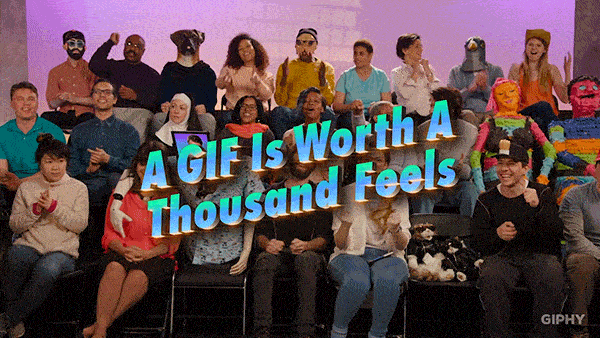
The History of GIFs and How To Use Them

Unless you’ve been living under a rock for the past 10 years, chances are you’re familiar with the GIF. Short for “Graphics Interchange Format,” the GIF has exploded in recent years and is now an integral part of digital day-to-day communications. It wasn’t always that way, though. In fact, not many people know the history of the GIF, but it’s is a whopping 30 years old, with the first one predating the internet itself. How, then, did these short looping animations transcend their obscure ’80’s roots and become a fundamental offering in today’s communications? Who created the GIF? What is GIF short for? Read on to find out.
GIF History: Who Created GIF?
First, let’s discuss the GIF pronunciation. Although you pronounce “graphic” with a hard “g,” the inventor of the GIF, Steve Wilhite, is adamant that you pronounce GIF with a soft “g,” as in “jiffy.” Don’t feel bad if you’ve been pronouncing it incorrectly, or if you continue to do so, as there are several reasons people of the internet prefer the hard “g” approach. For one, it alleviates confusion between the cute little films and the peanut butter brand. Two, it’s more fun to say. And three, it’s “graphic-ical interchange format,” not “germ-ical interchange format.”
If you have trouble remembering that, think of Wilhite’s moniker, which references the once-popular JIF commercial: “Choosy developers choose GIF.”

The Early Days of the GIF
Today’s GIFs run the gamut from simple to advanced, and from downright goofy to educational, with many falling well into the “satirical” category. Regardless of the tone of a file, GIFs have a way of adding an element of fun to just about any custom writing or social media post. Yet, when Wilhite was tasked by his employer, CompuServe, to create the GIF back in 1986, bringing “fun” to the internet was not exactly what the tech company had in mind. In fact, the internet hadn’t even been born yet.
Sandy Trevor, Wilhite’s boss at CompuServe, needed the programmer to solve two major problems for him. The first was that CompuServe — an early online service that provided hourly subscriptions to users who needed to access email and a way to transfer files — needed a simple graphics format that would seamlessly display across all computers.
Back in the early days of the computer, the PC market was split between several companies, including IBM, Atari, Commodore, Tandy and Apple. Each company had its own way of doing things, including displaying graphics. Despite how each brand chose to display graphics, all users shared a universal problem: space.
The second problem Trevor wanted Wilhite to solve was image quality. Computers back then were slow. (Remember the dial-up days?) In the late ’80s, a “high speed” dial-up connection was 1,200 baud. The average speed, however, was just 300 baud. Today, the average broadband connection is 40,000 times faster than that era’s fastest connection. What this meant was that for users to share images of quality, they needed to share super tiny files.

So, to recap: Wilhite needed to create super small files that users could transfer from device to device without taking up too much memory and while preserving the quality of the image. He found a way to do so with a compression algorithm, which he dubbed the Graphics Interchange Format.
Introducing Lempel-Ziv-Welch Compression Protocol
You may wonder why Trevor couldn’t have just relied on the JPEG. At the time that CompuServe tasked Wilhite with creating the compressed format, JPEG was well under construction. Though JPEG is a still favored file format today, it is best for photographs that contain high amounts of detail and that can withstand slight distortion.
What CompuServe users needed to transfer, however, were less detailed images, such as weather maps, stock quotes and graphs — simple images that would lose their meaning if distorted even in the slightest. To create a format that would accomplish CompuServe’s objectives, Wilhite used a compression practice called Lempel-Ziv-Welch.
Initially, LZW was used almost exclusively for the compression and transfer of still images. What made the protocol unique, however, is that it identified repeating patterns, simplified them and then compressed them without trimming any of the original image’s data. The end result was essentially a digital flipbook that used the same still image, just ever so slightly changed, on each repeating “page” to create a looping video that presented as a single image.
The Internet Is Under Construction
In the early days of the internet, custom writing services weren’t a thing, and website owners never dreamed they’d need to buy articles to declare the launch of their site. Rather, they just created GIFs.
If you were old enough to use the World Wide Web then, you might remember the “Under Construction” GIFs adorning nearly every new website on the internet. Though most looked more or less the same, there were a few that went viral before internet virality was even a thing. Those include the “dancing baby” (which was rather creepy) and the Hamster Dance website, which was a website featuring rows and rows of dancing hamsters.

When Wilhite created the GIF, he went above and beyond Trevor’s request and made it adaptable. Programmers, developers and the everyday computer user could layer various elements, including WordArt, logos, charts and images, on top of each other to create one dynamic custom image. He didn’t stop there, though — he also made it extensible. Instead of the GIF being proprietary to CompuServe, Wilhite made it so other programmers could use the formula on their browsers. It wasn’t long before Netscape, the largest browser in the 90s, made GIFs the standard.
Netscape may be obsolete now, but it played a huge role in the history of the GIF and the internet. Netscape was the first browser that allowed users to interact with images as opposed to just text. While clicking on an image or logo to access a new page may seem standard to you, it was revolutionary back then.
Because Wilhite designed GIFs to be shareable across all devices and bandwidths, it made sense that the Google of the ’90s would want to capitalize on it. In 1995, Netscape released Navigator 2.0, which supported both the GIF format and animated GIFs. This made it easier than ever for website owners to adorn their sites with animated and still images, which, aside from the overuse of them, lead to one major problem: A patent dispute.
Burn All .gifs
Like with any simple yet revolutionary concept, everyone used the GIF, but no one thought about the company behind the algorithm. Developers were writing and acquiring software that supported the format without ever once stopping to think that another company had patented LZW, the process that made the GIF possible. But a company had patented it, and that company was bound to take notice sooner or later.
In December of 1994, after years of developers having a free-for-all with the GIF, Unisys Corp decided it was time to make good on its patent. The company didn’t outright sue developers for patent infringement but instead made a statement clarifying that it would be charging a use license fee (which ranged from between .45% and .65%) for the use of its technology across certain categories of software that supported the GIF format. Developers’ reactions ranged from the sensible to the downright dramatic.
Some developers shrugged their shoulders and went ahead and created a new file format that was more or less a GIF but without the use of LZW technology. One such format was the PNG, which, at one point, was called PING — “Ping Is Not Gif.” Others, on the other hand, took Unisys’ actions as a personal slight and started the “Burn All GIFs” movement. On November 5, 1999, all developers gathered at their computers and burned all their remaining GIF files, essentially putting an end to the era of the GIF.

The Resurgence of the GIF
Like short film and abstract art, the GIF filled a void consumers weren’t aware existed until it disappeared. Not quite a short film and not quite a still image, the short, continuous, soundless loop that was the animated GIF could convey nuance in a way that text just couldn’t. Though it would take another decade and a half, the GIF would eventually resurge, which David McIntosh, the CEO of Tenor, a GIF search engine, attributes to internet users’ increasing use of shorthand.
According to McIntosh, communication has been reduced to “Lol” and “Rotfl,” acronyms that carry no weight or significant meaning. Anyone these days can type “Haha!” and not really mean it. However, to insert a GIF of Kitty from “That ’70s Show” laughing hysterically or of Leonardo DiCaprio on a yacht guffawing conveys genuine and thoughtful reaction. Not only that, but the GIF someone chooses can tell the recipient a lot about the sender’s true feelings. For instance, the Kitty GIF is one of pure delight, whereas Leo’s GIF is sarcasm at its finest.

It’s unclear in GIF history, exactly, when the GIF made its comeback, but come back it did. In fact, in 2013, a year after the Oxford Dictionary named “GIF” the word of the year, Steve Wilhite received a lifetime achievement award at the Webbys, which is when and where he decided to educate the world on the correct pronunciation of the file format.
While many people thought GIFs would be a passing fad, much like anything that is a throwback to some long-gone era, it’s held its ground even when other just as popular trends have come and gone. Whether because people are suckers for nostalgia or the internet has a pressing need for a visual way to communicate emotion (or both) doesn’t matter — what matters is that the GIF is here to stay. The question is, how will you make the format work for you?
Using GIFs in Your Custom Writing
It’s easy for CEOs and head honchos to overlook the GIF as nothing more than an unprofessional and lazy way to communicate with one’s audience, but the truth is that the internet loves the simple format. The longevity of the GIF is a testament to this truth. When you buy articles from your custom writing service, consider asking for social media add-ons that include a GIF or two. Here are a few reasons why:
- They’re Devour-able: As of the end of 2019, Giphy, which is just one of several GIF search engines, boasted 700 million daily users. Approximately 11 million hours of Giphy content is viewed daily, and 10 billion GIFs downloaded. To say that people want to see these looping animations is an understatement.
- They Provide a Nice Balance Between Image and Video: There is no shortage of statistics that tell us humans are visual creatures. In fact, 32% of marketers say they prioritize images in their marketing, compared to just 27% of those who prioritize blogging. Approximately 80% of marketers supplement text with visual assets on social media. Many consumers prefer video over images, but video is expensive. The GIF serves as a nice compromise that any brand, regardless of budget, can use.
- They’re Universal: Each platform caters to different content types. For instance, LinkedIn requires more in-depth and thoughtful posts. Twitter allows for no more than 280 characters. Instagram is all about imagery and videos. GIFs, however, are welcome across all platforms because, well, people love them.
- They Elicit a Range of Emotions: To paraphrase Alex Chung, the CEO of Giphy: A picture may be worth a thousand words, but the average GIF contains 60 frames. Therefore, a GIF is capable of conveying 60,000 words, the length of an average novel. As with a novel, a GIF can elicit a variety of emotions, but in just a few short seconds.

- There’s a GIF for Every Occasion: Don’t have the technology or know-how to create your own GIF? You don’t need to. According to Giphy, there are approximately 150 million original GIFs on the World Wide Web. Tumblr sees 23 million new GIFs daily, while another five million get shared via Facebook’s messenger on a day-to-day basis. The point is, there’s a GIF for every brand and every occasion and every piece of custom content you commission, so there’s no excuse not to tack one onto your content order.
How To Use GIFs in Your Content
How can you use GIFs in your content for the most impact? Here are a few ways our custom writing service uses GIFs to complement text and take a blog article to the next level:
- Explain Data: Infographics are a favored method for taking large datasets and breaking them down into digestible pieces, but GIFs do them one better. If you want to explain a single, complex concept — especially one that evolves over time — in a way the everyday user will understand, a GIF is a great way to do so. If you’re dubious, check out these 20 GIFs that will teach you more than any textbook ever did.
- Provide a Quick How-To: Innovative marketers realize the opportunity GIFs present to provide consumers with quick and easy-to-follow tutorials at a fraction of the cost of standard-length how-to videos. From showing consumers how to use new software to teaching them how to apply eyeshadow to demonstrating how the Pythagorean theorem works, you can create a GIF for just about any concept or product.
- Boost Clickthrough Rates: When used in email newsletters, GIFs boosted clickthrough rates by an average of 26%. That’s not all. Emails with GIFs garnered 12% more revenue than those without animation and experienced as much as a 109% increase in revenue. If that’s not a good enough reason to request GIFs from your custom writing service, we don’t know what is.
GIFs are Here to Stay
Like great written content, the GIF isn’t going anywhere — that’s clear from GIF history, which includes the format’s 30+ year history to its continued popularity today. Whether you currently invest in custom content or you’re getting started with the whole content marketing thing, it’s time to step up your content game with complementary GIFs. We’ll help you get started.
- The Google Quick Answer Box: What, Why and How? - December 20, 2023
- Top 10 Link-Building Strategies for Content Marketers - July 12, 2023
- 8 Types of Ecommerce Content You Should Start Using - May 15, 2023

